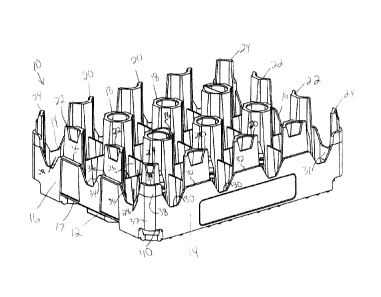Une partie des informations de ce site Web a été fournie par des sources externes. Le gouvernement du Canada n'assume aucune responsabilité concernant la précision, l'actualité ou la fiabilité des informations fournies par les sources externes. Les utilisateurs qui désirent employer cette information devraient consulter directement la source des informations. Le contenu fourni par les sources externes n'est pas assujetti aux exigences sur les langues officielles, la protection des renseignements personnels et l'accessibilité.
L'apparition de différences dans le texte et l'image des Revendications et de l'Abrégé dépend du moment auquel le document est publié. Les textes des Revendications et de l'Abrégé sont affichés :
| (12) Brevet: | (11) CA 2699804 |
|---|---|
| (54) Titre français: | PLATEAU EMPILABLE PEU PROFOND |
| (54) Titre anglais: | LOW DEPTH STACKABLE TRAY |
| Statut: | Réputé périmé |
| (51) Classification internationale des brevets (CIB): |
|
|---|---|
| (72) Inventeurs : |
|
| (73) Titulaires : |
|
| (71) Demandeurs : |
|
| (74) Agent: | MACRAE & CO. |
| (74) Co-agent: | |
| (45) Délivré: | 2017-01-10 |
| (22) Date de dépôt: | 2010-04-12 |
| (41) Mise à la disponibilité du public: | 2010-10-10 |
| Requête d'examen: | 2015-03-03 |
| Licence disponible: | S.O. |
| (25) Langue des documents déposés: | Anglais |
| Traité de coopération en matière de brevets (PCT): | Non |
|---|
| (30) Données de priorité de la demande: | ||||||
|---|---|---|---|---|---|---|
|
Un plateau pour contenants, comme des bouteilles de boisson, comprend une base et une pluralité de colonnes intérieures sétendant vers le haut à partir de la base. Une pluralité de colonnes sétendent vers le haut le long dau moins une partie de la périphérie du plateau. Des parois latérales sétendent le long des côtés du plateau et des parois dextrémité sétendent le long des extrémités du plateau, les colonnes dextrémité étant reliées aux parois latérales par les parois dangle. Ces dernières font saillie vers le haut à une hauteur supérieure à celle des parois latérales et des parois dextrémité et comprennent une ouverture à un bord inférieur de celles-ci pour recevoir une partie dangle dun plateau identique emboîté sous celles-ci. Dans une autre caractéristique indépendante, des séparateurs et/ou les parois comprennent des évidements le long des bords supérieurs pour réduire lencombrement global du plateau.
A tray for containers, such as beverage bottles, includes a base and a plurality of interior columns extending upwardly from the base. A plurality of columns extend upwardly along at least a portion of the periphery of the tray. Side walls extend along the sides of the tray and end walls extend along the ends of the tray, the end walls connected to the side walls by corner walls. The corner walls protrude upwardly higher than the side walls and end walls and include an opening at a lower edge thereof for receiving a corner portion of an identical tray nested therebelow. In another, independent feature, dividers and/or the walls include recesses along uppermost edges to reduce the overall footprint of the tray.
Note : Les revendications sont présentées dans la langue officielle dans laquelle elles ont été soumises.
Note : Les descriptions sont présentées dans la langue officielle dans laquelle elles ont été soumises.

Pour une meilleure compréhension de l'état de la demande ou brevet qui figure sur cette page, la rubrique Mise en garde , et les descriptions de Brevet , États administratifs , Taxes périodiques et Historique des paiements devraient être consultées.
| Titre | Date |
|---|---|
| Date de délivrance prévu | 2017-01-10 |
| (22) Dépôt | 2010-04-12 |
| (41) Mise à la disponibilité du public | 2010-10-10 |
| Requête d'examen | 2015-03-03 |
| (45) Délivré | 2017-01-10 |
| Réputé périmé | 2021-04-12 |
Il n'y a pas d'historique d'abandonnement
| Type de taxes | Anniversaire | Échéance | Montant payé | Date payée |
|---|---|---|---|---|
| Le dépôt d'une demande de brevet | 400,00 $ | 2010-04-12 | ||
| Taxe de maintien en état - Demande - nouvelle loi | 2 | 2012-04-12 | 100,00 $ | 2012-03-26 |
| Taxe de maintien en état - Demande - nouvelle loi | 3 | 2013-04-12 | 100,00 $ | 2013-03-27 |
| Taxe de maintien en état - Demande - nouvelle loi | 4 | 2014-04-14 | 100,00 $ | 2014-03-26 |
| Requête d'examen | 800,00 $ | 2015-03-03 | ||
| Taxe de maintien en état - Demande - nouvelle loi | 5 | 2015-04-13 | 200,00 $ | 2015-03-06 |
| Taxe de maintien en état - Demande - nouvelle loi | 6 | 2016-04-12 | 200,00 $ | 2016-03-09 |
| Taxe finale | 300,00 $ | 2016-11-28 | ||
| Taxe de maintien en état - brevet - nouvelle loi | 7 | 2017-04-12 | 200,00 $ | 2017-03-08 |
| Taxe de maintien en état - brevet - nouvelle loi | 8 | 2018-04-12 | 200,00 $ | 2018-03-07 |
| Taxe de maintien en état - brevet - nouvelle loi | 9 | 2019-04-12 | 200,00 $ | 2019-03-20 |
| Taxe de maintien en état - brevet - nouvelle loi | 10 | 2020-04-14 | 250,00 $ | 2020-04-01 |
Les titulaires actuels et antérieures au dossier sont affichés en ordre alphabétique.
| Titulaires actuels au dossier |
|---|
| REHRIG PACIFIC COMPANY |
| Titulaires antérieures au dossier |
|---|
| APPS, WILLIAM P. |